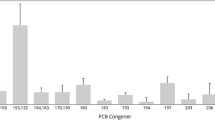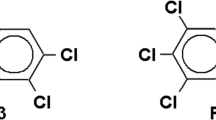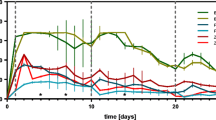Abstract
Introduction
Five liver samples of two different ray species (Gymnura altavela and Zapteryx brevirostris) off the coast of Rio de Janeiro, Brazil, were analyzed for their pollution with anthropogenic and naturally occurring organohalogen compounds.
Material and methods
The samples were extracted with accelerated solvent extraction, and after a clean-up procedure, organohalogen compounds were separated by a modified group separation on activated silica. Subsequent analyses were done by targeted and non-targeted gas chromatography–mass spectrometry in the electron capture negative ion mode.
Results and discussion
“Classic” organohalogen compounds such as polychlorinated biphenyls (PCBs), polybrominated diphenyl ethers (PBDEs), and technical 1,1,1-trichloro-2,2-di(4-chlorophenyl)ethane (DDT) were detected and quantified. PCBs generally exceeded the parts per million level and represented up to 90% of the total contamination of the ray livers. High concentrations were also detected for p,p′-DDE. Non-targeted full scan investigations lead to the detection of an abundant trichlorinated compound which was identified as a new DDT metabolite in biota. Different PBDE congeners and several halogenated natural products were quantified as well. In addition, polychlorinated terphenyls were identified and analyzed in the two species. Moreover, both ray species showed different fatty acid patterns and stable carbon isotope signatures.
Conclusions
The two ray species showed high concentrations of organohalogen compounds in their liver tissue. Varied δ 13C values by up to 3.1‰ indicated that the two ray species were living in different habitats.






Similar content being viewed by others
References
de Azevedo e Silva CE, Azeredo A, de Cassia Lima Dias A, Costa P, Lailson-Brito J, Malm O, Guimaraes JRD, Torres JPM (2009) Organochlorine compounds in sharks from the Brazilian coast. Mar Pollut Bull 58:294–298
de Boer J (2000) Polychlorinated terphenyls. The handbook of environmental chemistry, vol 3K. Springer, Berlin, pp 43–59
de Souza AS, Torres JPM, Meire RO, Neves RC, Couri MS, Serejo CS (2008) Organochlorine pesticides (OCs) and polychlorinated biphenyls (PCBs) in sediments and crabs (Chasmagnathus granulata, Dana, 1851) from mangroves of Guanabara Bay, Rio de Janeiro State, Brazil. Chemosphere 73:S186–S192
Dorneles PR, Lailson-Brito J, Dirtu AC, Weijs L, Azevedo AF, Torres JPM, Malm O, Neels H, Blust R, Das K, Covaci A (2009) Anthropogenic and naturally-produced organobrominated compounds in marine mammals from Brazil. Environ Int 36:60–67
Fisk AT, Holst M, Hobson KA, Duffe J, Moisey J, Norstrom RJ (2002) Persistent organochlorine contaminants and enantiomeric signatures of chiral pollutants in ringed seals (Phoca hispida) collected on the east and west side of the Northwater Polynya, Canadian arctic. Arch Environ Contam Toxicol 42:118–126
Gaul S, Vetter W (2008) Photolytic dehalogenation of the marine halogenated natural product Q1. Chemosphere 70(9):1721–1729
Gaul S, von der Recke R, Tomy G, Vetter W (2006) Anaerobic transformation of a technical brominated diphenyl ether mixture by super-reduced vitamin B12 and dicyanocobinamide. Environ Toxicol Chem 25:1283–1290
Gomes UL, Signori CN, Gadig OBF, Santos HRS (2010) Guia de identificação de tubarões e raias do Rio de Janeiro. Technical Books, Rio de Janeiro, p 234
Gribble GW (2010) Naturally occurring organohalogen compounds—a comprehensive update. Prog Chem Org Nat Prod 91:1–505
Gribble GW, Blank DH, Jasinski JP (1999) Synthesis and identification of two halogenated bipyrroles present in seabird eggs. Chem Comm 21:2195–2196
Hiebl J, Melcher J, Gundersen H, Schlabach M, Vetter W (2006) Identification and quantification of polybrominated hexahydroxanthene derivatives and other halogenated natural products in commercial fish and other marine samples. J Agric Food Chem 54:2652–2657
Hobson KA, Welch HE (1992) Determination of trophic relationships within a high arctic marine food web using delta 13C and delta 15N analysis. Mar Ecol Prog Ser 84:9–18
Kalantzi IO, Brown FR, Caleffi M, Goth-Goldstein R, Petreas M (2009) Polybrominated diphenyl ethers and polychlorinated biphenyls in human breast adipose samples from Brazil. Environ Int 35:113–117
Kjerfve B, Ribeiro CHA, Dias GTM, Filippo AM, da Silva QV (1997) Oceanographic characteristics of an impacted coastal bay: Baía de Guanabara, Rio de Janeiro, Brazil. Continental Shelf Res 17:1609–1643
Krock B, Vetter W, Luckas B (1997) PCB/toxaphene group separation on silica prior to congener specific determination of toxaphene residues in fish and other samples by GC/ECD. Chemosphere 35:1519–1530
Marsh G, Stenutz R, Bergman A (2003) Synthesis of hydroxylated and methoxylated polybrominated diphenyl ethers—natural products and potential polybrominated diphenyl ether metabolites. Eur J Org Chem 14:2566–2576
Marsh G, Athanasiadou M, Athanassiadis I, Bergman A, Endo T, Haraguchi K (2005) Identification, quantification, and synthesis of a novel dimethoxylated polybrominated biphenyl in marine mammals caught off the coast of Japan. Environ Sci Technol 39:8684–8690
McConnaughey T, McRoy CP (1979) Food-web structure and the fractionation of carbon isotopes in the Bering Sea. Mar Biol 53:257–262
McEachran J, Fechhelm J (1998) Fishes of the Gulf of Mexico. Volume 1: Myxiniformes to Gasterosteiformes. University of Texas Press, Austin
Melcher J, Olbrich D, Marsh G, Nikiforov V, Gaus C, Gaul S, Vetter W (2005) Tetra- and tribromophenoxyanisoles in marine samples from Oceania. Environ Sci Technol 39:7784–7789
Minagawa M, Wada E (1984) Stepwise enrichment of 15N along food chains: further evidence and the relation between δ15N and animal age. Geochim Cosmochim Acta 48:1135–1140
Paasivirta J (ed) (2000) New types of persistent halogenated compounds. The handbook of environmental chemistry, vol 3K. Springer, Berlin, pp 1–366
Perin G, Fabris R, Manente S, Rebello Wagener A, Hamacher C, Scotto S (1997) A five-year study on the heavy-metal pollution of Guanabara Bay sediments (Rio de Janeiro, Brazil) and evaluation of the metal bioavailability by means of geochemical speciation. Wat Res 31:3017–3028
Post DM (2002) Using stable isotopes to estimate trophic position: models, methods and assumptions. Ecology 83:703–718
Quinete N, Lavandier R, Dias P, Taniguchi S, Montone R, Moreira I (2011) Specific profiles of polybrominated diphenylethers (PBDEs) and polychlorinated biphenyls (PCBs) in fish and tucuxi dolphins from the estuary of Paraíba do Sul River, Southeastern Brazil. Mar Pollut Bull 62:440–446
Remberg G, Sandra P, Nyiry W, Winker N, Nikiforov A (1998) Calculation of the polychlorinated terphenyl congener distribution and gas chromatographic retention behavior of selected single standards on four stationary liquid phases. Fresenius J Anal Chem 362:404–408
Renberg L, Sundstrom G, Reutergardh L (1978) Polychlorinated terphenyls (PCT) in Swedish white-tailed eagles and in grey seals: a preliminary study. Chemosphere 7:477–482
Silva CS, Rodrigues JCV, Câmara NL (1990) Saneamento báisico e problemas ambientais na região metropolitana do Rio de Janeiro. Revista Brasielira de Geografia 52:5–106
Strandberg B, Bandh C, van Bavel B, Bergqvist PA, Broman D, Naf C, Pettersen H, Rappe C (1998) Concentrations, biomagnification and spatial variation of organochlorine compounds in a pelagic food web in the northern part of the Baltic Sea. Sci Total Environ 217:143–154
Teuten EL, Xu L, Reddy CM (2005) Two abundant bioaccumulated halogenated compounds are natural products. Science (Washington, DC, U S) 307:917–920
Thurnhofer S, Vetter W (2006) Application of ethyl esters and d 3 -methyl esters as internal standards for the gas chromatographic quantification of transesterified fatty acid methyl esters in food. J Agric Food Chem 54:3209–3214
Tittlemier SA, Borrell A, Duffe J, Duignan PJ, Fair P, Hall A, Hoekstra P, Kovacs KM, Krahn MM, Lebeuf M, Lydersen C, Muir D, O’Hara T, Olsson M, Pranschke J, Ross P, Siebert U, Stern G, Tanabe S, Norstrom R (2002) Global distribution of halogenated dimethyl bipyrroles in marine mammal blubber. Arch Environ Contam Toxicol 43:244–255
Vasconcelos MA, Ferreira WJ, Pereira RC, Cavalcanti DN, Teixeira VL (2010) Chemical constituents from the red alga Plocamium brasiliense (Greville) M. Howe and W.R. Taylor. Biochem Syst Ecol 38:119–121
Vetter W (2006) Marine halogenated natural products of environmental relevance. Rev Environ Contam Toxicol 188:1–57
Vetter W, Jun W (2003) Non-polar halogenated natural products bioaccumulated in marine samples. II. Brominated and mixed halogenated compounds. Chemosphere 52:423–431
Vetter W, Luckas B (1995) Synthesis, isolation, and chromatography of perdeuterated alpha-1,2,3,4,5,6-hexachlorocyclohexane. J High Resolut Chromatogr 18:643–646
Vetter W, Hiebl J, Oldham NJ (2001) Determination and mass spectrometric investigation of a new mixed halogenated persistent component in fish and seal. Environ Sci Technol 35:4157–4162
Vetter W, Stoll E, Garson MJ, Fahey SJ, Gaus C, Mueller JF (2002) Sponge halogenated natural products found at parts-per-million levels in marine mammals. Environ Toxicol Chem 21:2014–2019
Vetter W, Armbruster W, Betson TR, Schleucher J, Kapp T, Lehnert K (2006) Baseline isotopic data of polyhalogenated compounds. Anal Chim Acta 577:250–256
Vetter W, Rosenfelder N, Kraan S, Hiebl J (2008) Structure and origin of the natural halogenated monoterpene MHC-1 and its concentrations in marine mammals and fish. Chemosphere 73:7–13
Voldner EC, Li YF (1995) Global usage of selected persistent organochlorines. Sci Total Environ 160/161:201–210
von der Recke R, Vetter W (2007) Photolytic transformation of polybrominated biphenyls leading to the structures of unknown hexa- to nonabromo-congeners. J Chromatogr A 1167:184–194
Weichbrodt M, Vetter W, Luckas B (2000) Microwave-assisted extraction and accelerated solvent extraction with ethyl acetate-cyclohexane before determination of organochlorines in fish tissue by gas chromatography with electron-capture detection. J AOAC Int 83:1334–1343
Wester PG, de Boer J, Brinkman UAT (1996) Determination of polychlorinated terphenyls in aquatic biota and sediment with gas chromatography/mass spectrometry using negative chemical ionization. Environ Sci Technol 30:473–480
WHO; Global Malaria Programme (2007) The use of DDT in malaria vector control, WHO position statement
Wu J, Vetter W, Gribble GW, Schneekloth J, John S, Blank DH, Görls H (2002) Structure and synthesis of the natural heptachloro-1′-methyl-1,2′-bipyrrole (Q1). Angew Chem Int Ed 41:1740–1743
Zepp RG, Wolfe NL, Azarraga LV, Cox RH, Pape CW (1977) Photochemical transformation of the DDT and methoxychlor degradation products, DDE and DMDE, by sunlight. Arch Environ Contam Toxicol 6:305–314
Author information
Authors and Affiliations
Corresponding author
Additional information
Responsible editor: Philippe Garrigues
Electronic supplementary material
Below is the link to the electronic supplementary material.
ESM 1
(PDF 21.3 kb)
Rights and permissions
About this article
Cite this article
Rosenfelder, N., Lehnert, K., Kaffarnik, S. et al. Thorough analysis of polyhalogenated compounds in ray liver samples off the coast of Rio de Janeiro, Brazil. Environ Sci Pollut Res 19, 379–389 (2012). https://doi.org/10.1007/s11356-011-0569-2
Received:
Accepted:
Published:
Issue Date:
DOI: https://doi.org/10.1007/s11356-011-0569-2




